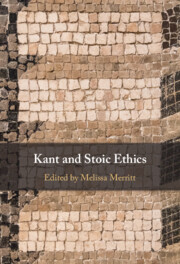Refine search
Actions for selected content:
92 results
Chapter 2 - Punishing the Transgressive Will
-
- Book:
- The Will in English Renaissance Drama
- Published online:
- 04 September 2025
- Print publication:
- 18 September 2025, pp 63-99
-
- Chapter
- Export citation
Introduction
-
-
- Book:
- Kant and Stoic Ethics
- Published online:
- 18 July 2025
- Print publication:
- 07 August 2025, pp 1-10
-
- Chapter
- Export citation
Chapter 7 - Kant’s Rejection of Stoic Eudaimonism
- from Part II - Virtue and Eudaimonia
-
-
- Book:
- Kant and Stoic Ethics
- Published online:
- 18 July 2025
- Print publication:
- 07 August 2025, pp 120-136
-
- Chapter
- Export citation
Chapter 12 - Anger Reinstated
- from Part III - Human Feeling and Ethical Development
-
-
- Book:
- Kant and Stoic Ethics
- Published online:
- 18 July 2025
- Print publication:
- 07 August 2025, pp 206-220
-
- Chapter
- Export citation
Chapter 1 - Ethical Formulae in Ancient Stoicism
- from Part I - Law and ‘Duty’
-
-
- Book:
- Kant and Stoic Ethics
- Published online:
- 18 July 2025
- Print publication:
- 07 August 2025, pp 13-30
-
- Chapter
- Export citation
Chapter 13 - Kant’s Philosophy of History as Stoic Consolation
- from Part III - Human Feeling and Ethical Development
-
-
- Book:
- Kant and Stoic Ethics
- Published online:
- 18 July 2025
- Print publication:
- 07 August 2025, pp 221-238
-
- Chapter
- Export citation
1 - Augustus and the Birth of Imperial Legality
- from Part I - Nevertheless, We Live According to the Laws
-
- Book:
- The God and the Bureaucrat
- Published online:
- 17 July 2025
- Print publication:
- 31 July 2025, pp 33-74
-
- Chapter
- Export citation

Kant and Stoic Ethics
-
- Published online:
- 18 July 2025
- Print publication:
- 07 August 2025
Chapter Five - Prodigal Pleasures
-
- Book:
- The Politics of Immorality in Ancient Rome
- Published online:
- 28 February 2025
- Print publication:
- 06 March 2025, pp 173-206
-
- Chapter
- Export citation
3 - Seneca’s Moral Epistles and Pauline Letters as Teachings
-
- Book:
- The Letters of Paul in their Roman Literary Context
- Published online:
- 05 December 2024
- Print publication:
- 12 December 2024, pp 135-198
-
- Chapter
- Export citation
Chapter 5 - From Agamemnon to Herakles
- from Part III - Tragedy and Translation in Late Modernism
-
- Book:
- Modernist Hellenism
- Published online:
- 21 November 2024
- Print publication:
- 28 November 2024, pp 247-284
-
- Chapter
- Export citation
1 - Ancient Influences on the Essay
- from Part I - Forming the British Essay
-
-
- Book:
- The Cambridge History of the British Essay
- Published online:
- 31 October 2024
- Print publication:
- 04 July 2024, pp 3-17
-
- Chapter
- Export citation
Chapter 1 - The City in Horace’s sermo
-
-
- Book:
- The Augustan Space
- Published online:
- 14 June 2024
- Print publication:
- 27 June 2024, pp 23-40
-
- Chapter
- Export citation
MORS INDIVIDVA AND AEQVA (SENECA, TROADES 401 AND 434)
-
- Journal:
- The Classical Quarterly / Volume 74 / Issue 1 / May 2024
- Published online by Cambridge University Press:
- 22 April 2024, pp. 364-365
- Print publication:
- May 2024
-
- Article
-
- You have access
- Open access
- HTML
- Export citation
Chapter 5 - Addressing Autocracy under Nero
-
- Book:
- The Body Politic in Roman Political Thought
- Published online:
- 01 February 2024
- Print publication:
- 08 February 2024, pp 163-194
-
- Chapter
- Export citation
Chapter 13 - Philosophy
-
-
- Book:
- The Cambridge Critical Guide to Latin Literature
- Published online:
- 04 January 2024
- Print publication:
- 18 January 2024, pp 700-752
-
- Chapter
- Export citation
Chapter 7 - The Political Bee (Apis politica)
-
- Book:
- The Trojan Horse and Other Stories
- Published online:
- 09 November 2023
- Print publication:
- 11 January 2024, pp 163-186
-
- Chapter
- Export citation
Chapter 4 - Avoiding Distress
- from Part II - Case Studies
-
- Book:
- Medicine and Practical Ethics in Galen
- Published online:
- 14 December 2023
- Print publication:
- 04 January 2024, pp 69-94
-
- Chapter
-
- You have access
- Open access
- HTML
- Export citation
Chapter 3 - Blindness as Metaphorical Death
-
- Book:
- Blindness and Spectatorship in Ancient and Modern Theatres
- Published online:
- 30 November 2023
- Print publication:
- 14 December 2023, pp 109-132
-
- Chapter
- Export citation
Chapter 1 - Questions and Answers
-
- Book:
- Ephorus of Cyme and Greek Historiography
- Published online:
- 30 November 2023
- Print publication:
- 14 December 2023, pp 10-60
-
- Chapter
- Export citation
